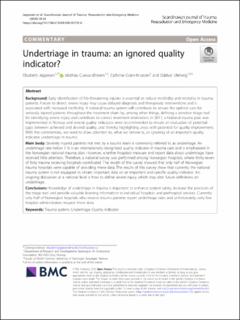| dc.contributor.author | Jeppesen, Elisabeth | |
| dc.contributor.author | Cuevas-Østrem, Mathias | |
| dc.contributor.author | Gram-Knutsen, Cathrine | |
| dc.contributor.author | Uleberg, Oddvar | |
| dc.date.accessioned | 2023-02-08T08:12:09Z | |
| dc.date.available | 2023-02-08T08:12:09Z | |
| dc.date.created | 2020-05-25T13:01:02Z | |
| dc.date.issued | 2020 | |
| dc.identifier.citation | Jeppesen, E., Cuevas-Østrem, M., Gram-Knutsen, C., & Uleberg, O. (2020). Undertriage in trauma: an ignored quality indicator?. Scandinavian journal of trauma, resuscitation and emergency medicine, 28, 1-3. | en_US |
| dc.identifier.issn | 1757-7241 | |
| dc.identifier.uri | https://hdl.handle.net/11250/3049095 | |
| dc.description.abstract | Background
Early identification of life-threatening injuries is essential to reduce morbidity and mortality in trauma patients. Failure to detect severe injury may cause delayed diagnosis and therapeutic interventions and is associated with increased morbidity. A national trauma system will contribute to ensure the optimal care for seriously injured patients throughout the treatment chain by, among other things, defining a sensitive triage tool for identifying severe injury and contribute to correct treatment destination. In 2017, a National trauma plan was implemented in Norway and several quality indicators were recommended to ensure an evaluation of potential gaps between achieved and desired quality, and thereby highlighting areas with potential for quality improvement. With this commentary, we want to draw attention to, what we believe is, an ignoring of an important quality indicator: undertriage in trauma.
Main body
Severely injured patients not met by a trauma team is commonly referred to as undertriage. An undertriage rate below 5 % is an internationally recognized quality indicator in trauma care and is emphasized in the Norwegian national trauma plan. However, whether hospitals measure and report data about undertriage, have received little attention. Therefore, a national survey was performed among Norwegian hospitals, where thirty-seven of forty trauma receiving hospitals contributed. The results of the survey showed that only half of Norwegian trauma hospitals were capable of providing these data. The results of this survey show that currently the national trauma system is not equipped to obtain important data on an important and specific quality indicator. An ongoing discussion at a national level is how to define severe injury, which may alter future definitions on undertriage.
Conclusions
Knowledge of undertriage in trauma is important to enhance patient safety, increase the precision of the triage tool and provide valuable learning information to individual hospitals and prehospital services. Currently only half of Norwegian hospitals who receive trauma patients report undertriage rates and unfortunately, only few hospital administrators request these data. | en_US |
| dc.language.iso | eng | en_US |
| dc.publisher | BMC | en_US |
| dc.rights | Navngivelse 4.0 Internasjonal | * |
| dc.rights.uri | http://creativecommons.org/licenses/by/4.0/deed.no | * |
| dc.title | Undertriage in Trauma: An Ignored Quality Indicator? | en_US |
| dc.type | Peer reviewed | en_US |
| dc.type | Journal article | en_US |
| dc.description.version | publishedVersion | en_US |
| dc.rights.holder | The authors | en_US |
| dc.subject.nsi | VDP::Medisinske Fag: 700 | en_US |
| dc.source.volume | 34 | en_US |
| dc.source.journal | Scandinavian Journal of Trauma, Resuscitation and Emergency Medicine | en_US |
| dc.source.issue | 28 | en_US |
| dc.identifier.doi | 10.1186/s13049-020-00729-6 | |
| dc.identifier.cristin | 1812441 | |
| cristin.ispublished | true | |
| cristin.fulltext | original | |
| cristin.qualitycode | 1 | |

